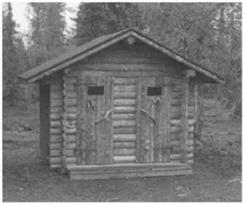As previously suggested in terms of building form and function, there are also certain materials and finishes that are more appropriate to the outdoors so as to reinforce the contrast with urban places. Therefore, while the layout should be to a high standard, materials should wherever possible be ones that are the least urban or domestic.
A variety of construction methods can be used, but the choice depends on the location.
Timber
This can be traditional log-cabin construction using round logs of substantial but not over-large dimensions. This works for bigger structures but not smaller ones, as the horizontal emphasis given by the logs conflicts with square or more vertically proportioned buildings. A good overhang to the roof with protruding beams and rafters, shake (shingle), turf or split-log roof looks good. However, this technique is generally not suited to Britain, as it is not traditional, but in central and northern Europe and North America, in forests of big trees it is a good method. This type of construction is naturally well insulated. Interior partitions of boards, open roof spaces with roof lights or high-level windows in the gables work effectively. Materials can be used on site unless special construction techniques are used.
Sawn timber can be used in all manner of ways. In Scandinavia, construction methods traditional to the landscape have been adapted for use in recreation buildings. Timber frames clad in overlapping vertical boarding and roofed with specially milled boards for waterproofing work very well in a drier continental climate. In wetter conditions such as Britain or the Pacific Northwest of the USA, where timber warps, this method is not suitable unless waterproof material can be used beneath the roofing timber. Shakes (shingles) can be used for roofing, as can other materials such as profile steel, which can be obtained with integral insulation. The coarser textures of wide roughly sawn boards and board-on-board or overlapping clapboarding blend with those found in wilder settings. Vertical boarding looks good in forests with plenty of vertical
|
A toilet building made of logs at Akasamylly in Finnish Lapland. The result is a little ‘rustic’ because the logs are small. However, the main problem is the sole use of window holes cut into the doors to give light. This is inadequate, and may cause privacy problems. |
shapes. Horizontal boarding can look better in open landscapes with more horizontal lines.
Timber can be left to weather to a dull silvery grey, which fits into most landscapes. Stains can also be used to give colour and to help preserve and fireproof the wood. Bright colours should be avoided in favour of the more subdued tones found in the landscape—rusty red, ochre, mossy green, greys, sandy browns and black—which relate to the rock, soil and natural vegetation of the locality.
Buildings often need to be made to hug the ground to reduce their visual impact, and so darker colours should be used on the roofs than on the walls. Emphasis can be given to the doors and certain parts of the framing, perhaps with a brighter colour used sparingly.




